新目标英语七年级下册第九单元教案
新版新目标七年级英语下册unit9教学设计.doc(推荐五篇)
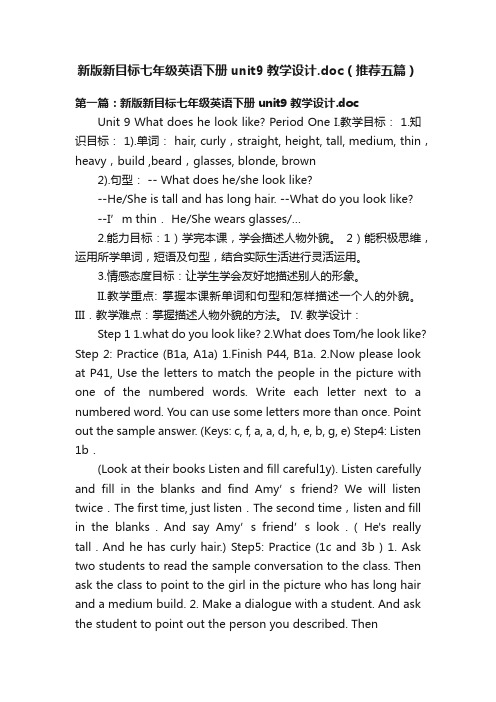
新版新目标七年级英语下册unit9教学设计.doc(推荐五篇)第一篇:新版新目标七年级英语下册unit9教学设计.docUnit 9 What does he look like? Period One I.教学目标: 1.知识目标: 1).单词: hair, curly,straight, height, tall, medium, thin,heavy,build ,beard,glasses, blonde, brown2).句型: -- What does he/she look like?--He/She is tall and has long hair. --What do you look like?--I’m thin.He/She wears glasses/…2.能力目标:1)学完本课,学会描述人物外貌。
2)能积极思维,运用所学单词,短语及句型,结合实际生活进行灵活运用。
3.情感态度目标:让学生学会友好地描述别人的形象。
II.教学重点: 掌握本课新单词和句型和怎样描述一个人的外貌。
III.教学难点:掌握描述人物外貌的方法。
IV. 教学设计:Step 1 1.what do you look like? 2.What does Tom/he look like? Step 2: Practice (B1a, A1a) 1.Finish P44, B1a. 2.Now please look at P41, Use the letters to match the people in the picture with one of the numbered words. Write each letter next to a numbered word. You can use some letters more than once. Point out the sample answer. (Keys: c, f, a, a, d, h, e, b, g, e) Step4: Listen 1b.(Look at their books Listen and fill careful1y). Listen carefully and fill in the blanks and find Amy’s friend? We will listen twice.The first time, just listen.The second time,listen and fill in the blanks.And say Amy’s friend’s look.( He's really tall.And he has curly hair.) Step5: Practice (1c and 3b ) 1. Ask two students to read the sample conversation to the class. Then ask the class to point to the girl in the picture who has long hair and a medium build. 2. Make a dialogue with a student. And ask the student to point out the person you described. ThenSs practice the dialogue in pairs. 3.(3b) 1). 2). Act the dialogue. 3). Finish the form. Step 6 make sentences (Section B 1b) Step 7 describe(shelfcheck3) Step 8 a guessing game (SectionB2c) Step9 homework Describe your family member and draw a picture of him/her.Period TwoI.教学目标: 1.知识目标: 1).单词:always, captain, popular,team, good-looking, a little bit, joke, never, stop, teeny, huge, dreamer, wise 2).句型:如同第一课时。
新课标七年级英语下册第九单元全单元教案
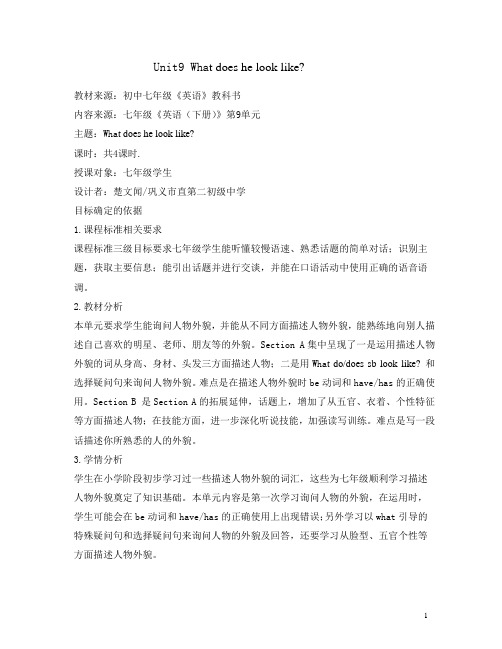
Unit9 Wha t does he look like?教材来源:初中七年级《英语》教科书内容来源:七年级《英语(下册)》第9单元主题:Wha t does he look like?课时:共4课时. 授课对象:七年级学生设计者:楚文闻/巩义市直第二初级中学目标确定的依据1.课程标准相关要求课程标准三级目标要求七年级学生能听懂较慢语速、熟悉话题的简单对话;识别主题,获取主要信息;能引出话题并进行交谈,并能在口语活动中使用正确的语音语调。
2.教材分析本单元要求学生能询问人物外貌,并能从不同方面描述人物外貌,能熟练地向别人描述自己喜欢的明星、老师、朋友等的外貌。
Section A集中呈现了一是运用描述人物外貌的词从身高、身材、头发三方面描述人物;二是用Wha t do/does sb look like? 和选择疑问句来询问人物外貌。
难点是在描述人物外貌时be动词和have/has的正确使用。
Section B 是Section A的拓展延伸,话题上,增加了从五官、衣着、个性特征等方面描述人物;在技能方面,进一步深化听说技能,加强读写训练。
难点是写一段话描述你所熟悉的人的外貌。
3.学情分析学生在小学阶段初步学习过一些描述人物外貌的词汇,这些为七年级顺利学习描述人物外貌奠定了知识基础。
本单元内容是第一次学习询问人物的外貌,在运用时,学生可能会在be动词和have/has的正确使用上出现错误;另外学习以what引导的特殊疑问句和选择疑问句来询问人物的外貌及回答,还要学习从脸型、五官个性等方面描述人物外貌。
Unit 9 Wha t does he look like?第一课时Section A 1a-2c【教学目标】1.通过课前预习和课堂练习,能准确说出本节课所学的描述人物外貌的词,并能从身高、身材、头发三个方面描述外貌。
2.通过小组活动,1)能运用What do/does … look like?询问外貌;2)能用选择疑问句询问外貌,并能准确地进行回答。
最新七年级英语下册《Unit 9 What does he look like》教学设计 (新版)人教新目标版
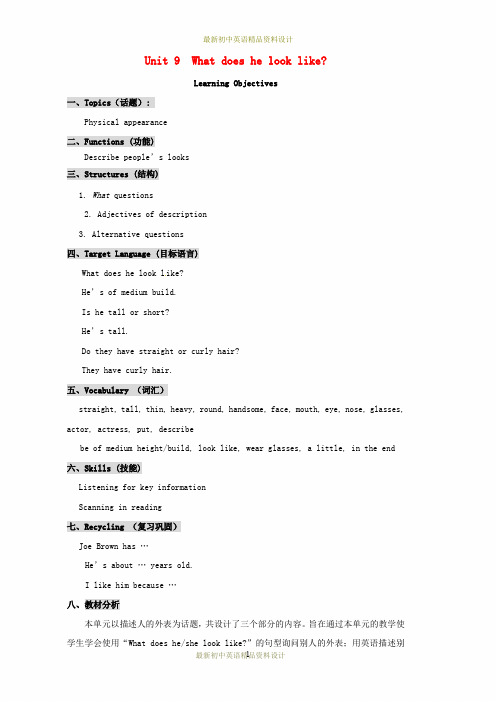
Unit 9 What does he look like?Learning Objectives一、Topics(话题):Physical appearance二、Functions (功能)Describe people’s looks三、Structures (结构)1. What questions2. Adjectives of description3. Alternative questions四、Target Language (目标语言)What does he look l ike?He’s of medium build.Is he tall or short?He’s tall.Do they have straight or curly hair?They have curly hair.五、Vocabulary (词汇)straight, tall, thin, heavy, round, handsome, face, mouth, eye, nose, glasses, actor, actress, put, describebe of medium height/build, look like, wear glasses, a little, in the end 六、Skills (技能)Listening for key informationScanning in reading七、Recycling (复习巩固)Joe Brown has …He’s about … years old.I like him because …八、教材分析本单元以描述人的外表为话题,共设计了三个部分的内容。
旨在通过本单元的教学使学生学会使用“What does he/she look like?”的句型询问别人的外表;用英语描述别人的发型,身高,身材以及其它特征。
并能学以致用,用所学知识描述自己的朋友,喜欢的老师及演员的等。
英语新目标英语七年级下第9单元说课稿 .doc
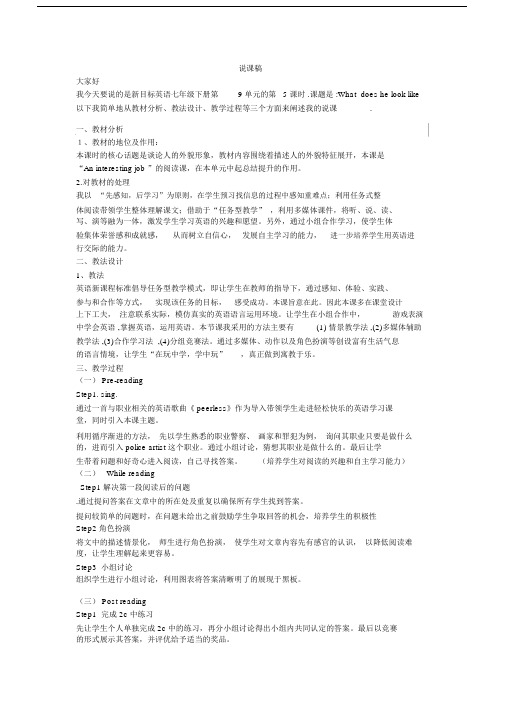
说课稿大家好我今天要说的是新目标英语七年级下册第9 单元的第 5 课时 .课题是 :What does he look like 以下我简单地从教材分析、教法设计、教学过程等三个方面来阐述我的说课.一、教材分析1、教材的地位及作用:本课时的核心话题是谈论人的外貌形象,教材内容围绕着描述人的外貌特征展开,本课是“An interesting job ”的阅读课,在本单元中起总结提升的作用。
2.对教材的处理我以“先感知,后学习”为原则,在学生预习找信息的过程中感知重难点;利用任务式整体阅读带领学生整体理解课文;借助于“任务型教学” ,利用多媒体课件,将听、说、读、写、演等融为一体,激发学生学习英语的兴趣和愿望。
另外,通过小组合作学习,使学生体验集体荣誉感和成就感,从而树立自信心,发展自主学习的能力,进一步培养学生用英语进行交际的能力。
二、教法设计1、教法英语新课程标准倡导任务型教学模式,即让学生在教师的指导下,通过感知、体验、实践、参与和合作等方式,实现该任务的目标,感受成功。
本课旨意在此。
因此本课多在课堂设计上下工夫,注意联系实际,模仿真实的英语语言运用环境。
让学生在小组合作中,游戏表演中学会英语 ,掌握英语,运用英语。
本节课我采用的方法主要有(1) 情景教学法 ,(2)多媒体辅助教学法 ,(3)合作学习法 ,(4)分组竞赛法。
通过多媒体、动作以及角色扮演等创设富有生活气息的语言情境,让学生“在玩中学,学中玩”,真正做到寓教于乐。
三、教学过程(一) Pre-readingStep1. sing.通过一首与职业相关的英语歌曲《 peerless》作为导入带领学生走进轻松快乐的英语学习课堂,同时引入本课主题。
利用循序渐进的方法,先以学生熟悉的职业警察、画家和罪犯为例,询问其职业只要是做什么的,进而引入 police artist 这个职业。
通过小组讨论,猜想其职业是做什么的。
最后让学生带着问题和好奇心进入阅读,自己寻找答案。
湖北省黄石市第十中学七年级英语下册 Unit 9 What does he look like教案 (新版)人教新目标版
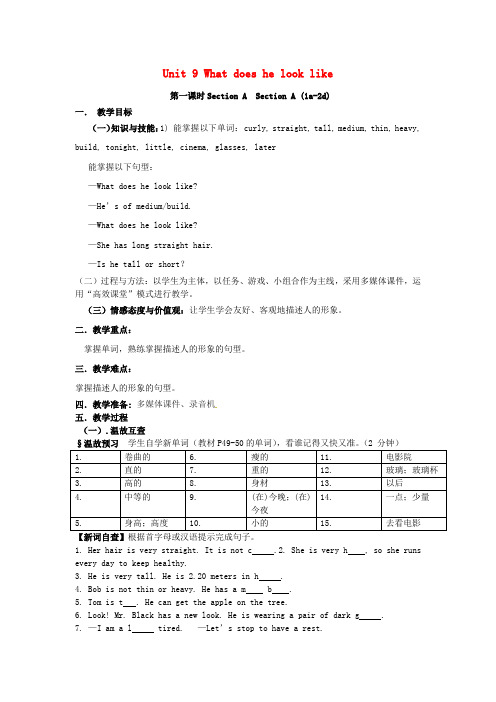
Unit 9 What does he look like第一课时Section A Section A (1a-2d)一.教学目标(一)知识与技能:1) 能掌握以下单词: curly, straight, tall, medium, thin, heavy, build, tonight, little, cinema, glasses, later能掌握以下句型:—What does he look like?—He’s of medium/build.—What does he look like?—She has long straight hair.—Is he tall or short?(二)过程与方法:以学生为主体,以任务、游戏、小组合作为主线,采用多媒体课件,运用“高效课堂”模式进行教学。
(三)情感态度与价值观:让学生学会友好、客观地描述人的形象。
二.教学重点:掌握单词,熟练掌握描述人的形象的句型。
三.教学难点:掌握描述人的形象的句型。
四.教学准备:多媒体课件、录音机五.教学过程(一).温故互查1. Her hair is very straight. It is not c .2. She is very h , so she runs every day to keep healthy.3. He is very tall. He is 2.20 meters in h .4. Bob is not thin or heavy. He has a m b .5. Tom is t . He can get the apple on the tree.6. Look! Mr. Black has a new look. He is wearing a pair of dark g .7. —I am a l tired. —Let’s stop to have a rest.8. We are g (看电影) tonight.(二).设问导读Ⅰ. Warming-up and revision找出三名外貌差异较大的学生来做比较,一个胖而高大的男生(a fat and tall boy),一个瘦而较矮的男生(a thi n and short boy),一个中等身材(of medium height)。
人教新目标七年级下册英语市级优质课获奖教案-Unit 9 What does he look like 第四课时

Unit 9 What does he look like?听说课SectionB (1a-1e ) 第四课时Learning Goals:一、语言知识:(常用词汇和句型)nose , mouth , r o un d , face , eye , singerMy favorite singer is John Jackson. He’s tall and thin. He has short curly brown hair.二、语言技能:继续让学生学会从其他角度描述人物外貌,如:头发、脸型、五官、眼镜、职业等;同时通过听说活动,进一步巩固描述人物外貌特征的形容词、短语及句型结构。
三、学习策略:通过看图画能尽可能完整的描述人的外貌;通过听力活动,能够根据所听内容中人物的外貌描述推断出正确的形象。
四、情感态度:通过描述同学、自己、偶像的外貌,简单地表达自己的观点或好恶,学会交换不同的看法,使学生在人际交往中学会尊重和理解别人。
并培养正确的审美观。
五、文化意识:在英美等西方国家,fat作为形容词,描述人时意义趋于消极,往往使用一些意义中性的词heavy或委婉的词语heavy-set等。
描述某人很瘦,常用slim显得更为礼貌。
描述男人用handsome , 描述女人用beautiful , pretty 。
通过描述不同人的外貌,对学生进行不同文化意识的渗透。
【设计意图】目标引领,表述了本节课的知识、能力、学习策略、情感态度和文化意识。
Teaching and leaning steps:StepI. Pre-listening activities1. Preview一、Look at P52, put the following into English orally, then write them down without looking at the text.(1)圆脸________________ (2)棕色的短卷发________________(3)戴眼镜_______________ (4)小嘴巴_____________________(5)大鼻子______________ (6)大眼睛__________________(7)又高又瘦 (8)我最喜欢的歌手二、Look at P52, put them into English orally, then write them down without looking at the text.1.我最喜欢的歌手是约翰·杰克逊。
初中英语人教版七年级下册新目标英语七年级下unit9教学设计

新目标英语七年级下unit9教学设计Step1 Greetings and lead inT: class begins. Good morning, boys and girls.Ss: Good morning, Miss Huo.T:Look at the picture ,what’s this ?It’s a schedule,but in chinese ,they are all subjects,what subjects do you know ? Let’s learn .What other subject do you know?(show the pictures and teach the new words)在学生站起来回答时可以让学生口头拼字母,并板书geography,science.physics和biology并教授新单词)Step2:Quick eyes1.We learn many subjects . Let’s do a quick eye, and see who has a good memory? 图片一张张闪现,让学生猜课程。
猜完后一起读一下。
2.Let’s look at the schedule again ,translate it into English(choose five lines ) Step3: 1aGuess what is my favorite subject?Yes ,you are so clever ,-What’s my favorite subject ?-My favorite subject is…(板书在黑板上)Step4:Ask and answerWhat’s your favorite subject?问两个学生之后再让学生来问,以link 的形式操练。
练个一组左右。
Step5:Listening 1bI know some of your favorite subjects. There are two girls. How about their favorite subjects? Listen and circle the subjects you hear.Step67: Free talk(过渡) the girl’s favorite subject is music. I think music is fun.How about you?让学生说出他们的看法和观点。
人教版新目标七年级英语下册 Unit 9教学设计
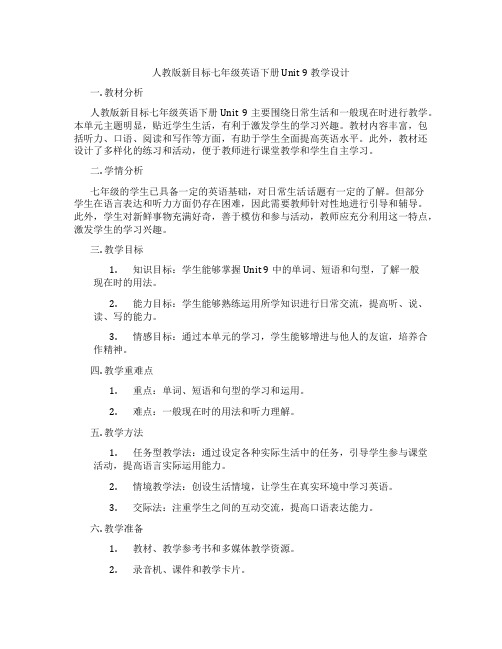
人教版新目标七年级英语下册 Unit 9教学设计一. 教材分析人教版新目标七年级英语下册Unit 9主要围绕日常生活和一般现在时进行教学。
本单元主题明显,贴近学生生活,有利于激发学生的学习兴趣。
教材内容丰富,包括听力、口语、阅读和写作等方面,有助于学生全面提高英语水平。
此外,教材还设计了多样化的练习和活动,便于教师进行课堂教学和学生自主学习。
二. 学情分析七年级的学生已具备一定的英语基础,对日常生活话题有一定的了解。
但部分学生在语言表达和听力方面仍存在困难,因此需要教师针对性地进行引导和辅导。
此外,学生对新鲜事物充满好奇,善于模仿和参与活动,教师应充分利用这一特点,激发学生的学习兴趣。
三. 教学目标1.知识目标:学生能够掌握Unit 9中的单词、短语和句型,了解一般现在时的用法。
2.能力目标:学生能够熟练运用所学知识进行日常交流,提高听、说、读、写的能力。
3.情感目标:通过本单元的学习,学生能够增进与他人的友谊,培养合作精神。
四. 教学重难点1.重点:单词、短语和句型的学习和运用。
2.难点:一般现在时的用法和听力理解。
五. 教学方法1.任务型教学法:通过设定各种实际生活中的任务,引导学生参与课堂活动,提高语言实际运用能力。
2.情境教学法:创设生活情境,让学生在真实环境中学习英语。
3.交际法:注重学生之间的互动交流,提高口语表达能力。
六. 教学准备1.教材、教学参考书和多媒体教学资源。
2.录音机、课件和教学卡片。
3.学生分组,准备角色扮演等活动。
七. 教学过程1.导入(5分钟)教师通过与学生打招呼,询问身体状况等日常话题,引入本课主题。
引导学生谈论日常生活中的一般现在时,激发学生学习兴趣。
2.呈现(10分钟)教师展示课件,呈现Unit 9的单词、短语和句型。
通过图片、例句等方式,对新词汇和短语进行讲解,让学生初步感知和理解。
3.操练(10分钟)教师学生进行口语练习,运用新学的单词、短语和句型进行角色扮演。
七年级英语下册Unit9Whatdoeshelooklike学案设计(新版)人教新目标版
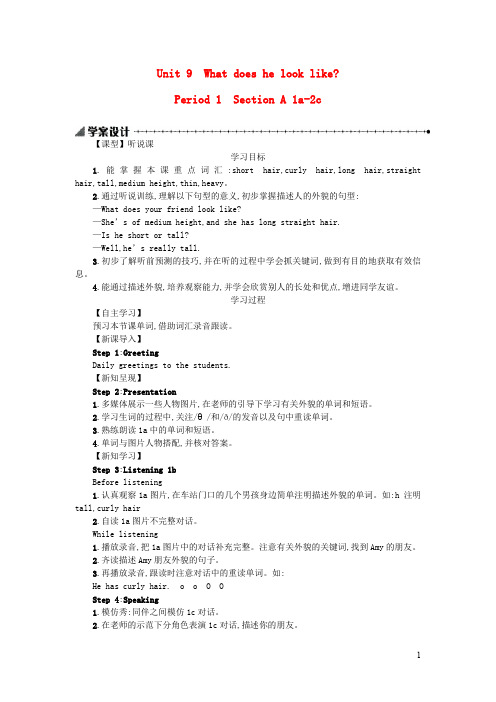
Unit 9 What does he look like?Period 1 Section A 1a-2c【课型】听说课学习目标1.能掌握本课重点词汇:short hair,curly hair,long hair,straight hair,tall,medium height,thin,heavy。
2.通过听说训练,理解以下句型的意义,初步掌握描述人的外貌的句型:—What does your friend look like?—She’s of medium height,and she has long straight hair.—Is he short or tall?—Well,he’s really tall.3.初步了解听前预测的技巧,并在听的过程中学会抓关键词,做到有目的地获取有效信息。
4.能通过描述外貌,培养观察能力,并学会欣赏别人的长处和优点,增进同学友谊。
学习过程【自主学习】预习本节课单词,借助词汇录音跟读。
【新课导入】Step 1:GreetingDaily greetings to the students.【新知呈现】Step 2:Presentation1.多媒体展示一些人物图片,在老师的引导下学习有关外貌的单词和短语。
2.学习生词的过程中,关注/θ/和/ð/的发音以及句中重读单词。
3.熟练朗读1a中的单词和短语。
4.单词与图片人物搭配,并核对答案。
【新知学习】Step 3:Listening 1bBefore listening1.认真观察1a图片,在车站门口的几个男孩身边简单注明描述外貌的单词。
如:h 注明tall,curly hair2.自读1a图片不完整对话。
While listening1.播放录音,把1a图片中的对话补充完整。
注意有关外貌的关键词,找到Amy的朋友。
2.齐读描述Amy朋友外貌的句子。
3.再播放录音,跟读时注意对话中的重读单词。
新目标英语七年级下册第九单元Unit9-Howwasyourweekend-(英语教案)
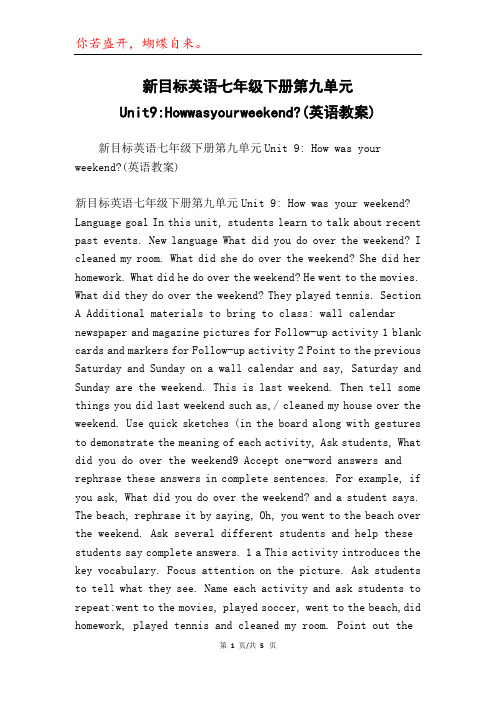
新目标英语七年级下册第九单元Unit9:Howwasyourweekend?(英语教案)新目标英语七年级下册第九单元Unit 9: How was your weekend?(英语教案)新目标英语七年级下册第九单元Unit 9: How was your weekend? Language goal In this unit, students learn to talk about recent past events. New language What did you do over the weekend? I cleaned my room. What did she do over the weekend? She did her homework. What did he do over the weekend? He went to the movies. What did they do over the weekend? They played tennis. Section A Additional materials to bring to class: wall calendar newspaper and magazine pictures for Follow-up activity 1 blank cards and markers for Follow-up activity 2 Point to the previous Saturday and Sunday on a wall calendar and say, Saturday and Sunday are the weekend. This is last weekend. Then tell some things you did last weekend such as,/ cleaned my house over the weekend. Use quick sketches (in the board along with gestures to demonstrate the meaning of each activity, Ask students, What did you do over the weekend9 Accept one-word answers and rephrase these answers in complete sentences. For example, if you ask, What did you do over the weekend? and a student says. The beach, rephrase it by saying, Oh, you went to the beach over the weekend. Ask several different students and help these students say complete answers. 1 a This activity introduces the key vocabulary. Focus attention on the picture. Ask students to tell what they see. Name each activity and ask students to repeat:went to the movies, played soccer, went to the beach,did homework, played tennis and cleaned my room. Point out thenumbered list of activities. Say each one again and ask students to repeat. Then ask students to match each activity with one of the pictures. Say, Write the letter of each activity next to the words. Point out the sample answer. Check the answers.1 b This activity gives students practice in understanding the target language in spoken conversation. Point to the activities in the picture in activity la.Ask students to tell what the person did in each picture.For example, She played tennis, or Lucy played tennis.Play the recording the first time. Students only listen. Play the recording a second time. This time say. Listen to the recording and write the days and times Lucy did each thing under the pictures. Point out the sample answer under the picture of Lucy playing tennis; on Saturday morning. Correct the answers. 1 c This activity provides guided oral practice using the target language. Point to the example conversation. Ask two students to read the dialogue to the class. Say, Now work with a partner. Student A, pretend to be Lucy. Student B, ask questions about what Lucy did on different days and times over the weekend.Talk about the activities in the picture. Students work in pairs. As they talk, move around the room monitoring their work. Offer language or pronunciation support as needed, 2a This activity gives students practice in understanding the key vocabulary in spoken conversation. Point to the five sentences and ask a student to read these sentences to the class. Say, You will hear t recording of a conversation. The people will talk about some of the activities and people, but they will not talk about others. Please underline the words you hear on the recording. Play the recording the first time. Students only listen. Play the recording a second time. This time, ask students to underline each word that is said on the tape. Point out the sample answer, grandmother. Correct theanswers. 2b This activity provides listening practice using the target language. Call attention to the pictures of Carol, Ben, and Emma and ask students to identify each person by name. Say, Now I will play the recording again. Listen to the students talking about what they aid over the weekend. Write C for Carol, B for Ben or E for Emma next to each statement in activity 2a. The first one has been done for you. Play the recording the first time. Students only listen. Point out the sample answer, S, in statement 1. Say,Sonia visited her grandmother. Play the recording again. Ask students to write a letter in front of each statement to show what each person did. Check the answers. 2c This activity provides guided oral and writing practice using the target language. Call attention to the dialogue and the list of activities in the box. Explain that students have to complete the dialogue using the activities words in the box. Students do the activity in pairs. When they have filled in the blanks, they practice the conversation. Have several pairs perform their conversations for the rest of the class. 3a This activity provides reading practice using the target language. Point to the three scenes in the picture. Ask students to describe what the person in each scene did. (Picture 1 shows: She went to the beach. Picture 2 shows: He did his homework and watched TV Picture 3 shows: She cleaned her room and studied for the math test.) After that, read the three dialogues with a student.The second part of each dialogue is incomplete. Say, The rest of the sentences are listed above the picture. Read them to the class or have a student read them. Say, Write the correct number on the blank lines in the speech bubbles to complete the conversations. Correct the answers. 3b This activity provides guided oral practice using the target language. Call attention to the example in speech bubbles. Ask a pair of students to readthe dialogue to the class. Say, Now practice asking and answering questions like this about what the people in the pictures did over the weekend. Practice in pairs. Use the dialogue as an example. Help students find partners. Then say, First read the dialogue together. Both students read both parts. Then make your own dialogues like that one. Tell what the people in activity 3a did over the weekend. Here is a sample dialogue: A: How was Sarahs weekend? B: It wasnt very good. She cleaned her room and studied for the math test. Ask pairs of students to present their dialogues to the class. 4 This activity provides oral practice using die target language. Play a model round of the game. Draw simple pictures of two things you did over the weekend. For example, a picture of a TV, and a picture of a tennis racket. Point to the picture of the Ty and ask a student to make a sentence about what you did (you watched TV). Do the same with the picture of the tennis racket and another student (you played tennis). Write the two sentences on the board and underline the -ed in watched and played and remind students to use the past tense. Now ask students to priictice the activity in groups of four. Each students draws two diings she or he might have done over the weekend on a piece of paper. The students then take turns to make sentences about each others pictures in past tense. Walk around the class offering assistance where necessary. Ask a student to draw two pictures about his or her last weekend on the bonrd. Class members guess the correct past tense sentences. Then write wh- words on the board (who, what, where, when, why, how) and encourage students to ask follow-up questions, for example. Who did you play tennis with9 Section B New language I played the guitar I studied geography. I went to the library. 1 a This activity introduces more key vocabulary. Call attention to the pictures. Askstudents to point to and use the past tense to describe as many of the activities as possible. Point to and describe any activities they cant describe. For example, I played the guitar. Then point to the numbered activities described in the list. Name the activities and ask students to repeat each one, After that, ask students to match each numbered phrase with a picture by writing the letter of each picture in the blank in front of the correct phrase.As students work, move around the room answering questions as needed. Check the answers 1 b This activity provides reading practice using the target language. Draw pictures of the happy face and unhappy face文档内容到此结束,欢迎大家下载、修改、丰富并分享给更多有需要的人。
初中英语《Unit9Whatdoeshelooklike》主题单元设计

3.成年人“男”、“女”用词的得体性
在用于口语交际中,在描述人物相貌涉及性别时,男女用词的得体 性也颇有讲究。一般来说,描述男孩用 boy,描述女孩用 girl。若 不区分性别,较正式的场合
信息化资 源
1、PPT、videos、Photoshop 2、Recorder and tape
常规资源 教 材
教学支撑 环境
教室
其 他 生本资源分享
学习活动设计
听说课的主要学习活动:
本专题有两个课时组成
一、情境感知
活动一:设计一个幸运猜物的游戏,学生选中一样衣物后,后面会出现一些与课 堂内容有关的简单问题,说唱或赠送一些小礼品,学生做完游戏,以此来调动学 生的积极性,
Section A 的
基础,重点是呈现描述人的外貌的基本词汇和询问人物外貌的句型。2a-2d 提 供了更为丰富的语境,教材通过听取信息的任务引导学生关注和区分描述人物外 貌的连个不同
句型:sb. is… 和 sb. has…, 同时在听力和口语活动中增加了选择疑问句的输 入和训练,穿插巩固前面所学的描述外貌的词汇,让学生能在相应的语境中综合 运用核心句型
为了借此与学生交流沟通,消除陌生感,活跃课堂气氛。学生跟随老师一起做幸 运猜物的游戏,在六样衣物中做出一个选择。通过游戏中讲衣着,找朋友等活动 为下面描述
外貌这个中心任务的展开做好热身准备。
活动二:设计创设一个游戏情景,在游戏中营造课堂气氛,并设计 what is your friend wearing?等简单问题来引出本节课的主题,描述人的外貌。然后呈现出潘 长江,姚明等
七年级英语下册 第9单元教案 新目标

新目标英语七年级下第九单元第三课时说课稿今天我说课的题目是Go for it!七年级下册的第九单元How was your weekend?的第三课时。
说课的内容包括四个部分:(一)说教材与教情;(二)说教学设计与设计理念;(三)说教法与学法;(四)说教学步骤。
(一)说教材与教情从本单元的题目How was your weekend?就可以知道本单元的语言目标是讨论曾经的活动或过去发生的事件,要求学生掌握的语法知识就是一般过去时。
一般过去时这一时态在Go for it!这套书里这是第一次出现,因此要让学生把一贯以来他们所熟悉的一般现在时暂时搁浅,而用新学的一般过去时来表述发生的事件,这就是本单元的重点也是难点所在。
要攻克这一重难点的关键,我认为在于能使学生对动词的过去时具备一定的熟巧度,并且这种熟巧度不仅应该表现在听说能力上,也应该体现在阅读和写作能力当中;不仅要在听和读的语言输入过程当中能够对这一时态有较强的敏感度,也要在说和写的语言输出过程中能够比较自然和自如地运用这一时态。
对一般过去时在语言中运用的这种熟巧度实际上也就是本单元预期达到的语言技能目标。
在本单元整体的知识和技能的大目标下,本课时作为本单元的第三课时,也就是本单元最后一个课时,它所覆盖的课本内容是Section B中的听力、阅读和写作。
根据我对Go for it!这套教材的理解,Section B的内容往往是对所在单元的基本知识和基本技能的拓展和提高。
那么,既然本堂课所要覆盖的内容是整个Section B,那本课时的课型就可预设为综合课,即整堂课将围绕知识和技能的综合训练和提高来展开活动,当然,也可将它看作是一堂复习课,因为本单元的基本知识将在本课时中得到比较全面的复习和综合。
本课时的知识目标将仍然是包含一般过去时的句型,而能力目标则定位于发展学生运用这一时态的综合能力。
在知识目标和能力目标的实现过程当中,将贯穿交际目标和情感目标,即让学生互相了解、交流和讨论自己的业余生活。
新目标七年级下册英语第九单元教案
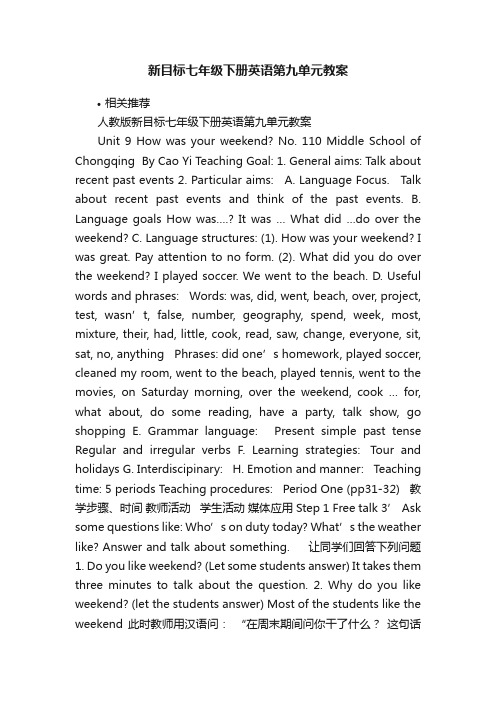
新目标七年级下册英语第九单元教案•相关推荐人教版新目标七年级下册英语第九单元教案Unit 9 How was your weekend? No. 110 Middle School of Chongqing By Cao Yi Teaching Goal: 1. General aims: Talk about recent past events 2. Particular aims: A. Language Focus. Talk about recent past events and think of the past events. B. Language goals How was….? It was … What did …do over the weekend? C. Language structures: (1). How was your weekend? I was great. Pay attention to no form. (2). What did you do over the weekend? I played soccer. We went to the beach. D. Useful words and phrases: Words: was, did, went, beach, over, project, test, wasn’t, false, number, geography, spend, week, most, mixture, their, had, little, cook, read, saw, change, everyone, sit, sat, no, anything Phrases: did one’s homework, played soccer, cleaned my room, went to the beach, played tennis, went to the movies, on Saturday morning, over the weekend, cook … for, what about, do some reading, have a party, talk show, go shopping E. Grammar language: Present simple past tense Regular and irregular verbs F. Learning strategies: Tour and holidays G. Interdiscipinary: H. Emotion and manner: Teaching time: 5 periods Teaching procedures: Period One (pp31-32) 教学步骤、时间教师活动学生活动媒体应用Step 1 Free talk 3’ Ask some questions like: Who’s on duty today? What’s the weather like? Answer and talk about something. 让同学们回答下列问题1. Do you like weekend? (Let some students answer) It takes them three minutes to talk about the question. 2. Why do you like weekend? (let the students answer) Most of the students like the weekend 此时教师用汉语问:“在周末期间问你干了什么?这句话用英语这么回答? Let the students guess. At last the teacher give them right answer 3. What did you do over the weekend?(板书、学习) 4. What did you do over the weekend? (Let sb. answer the question) I-played basketball. 5. 出示三张照片(有各种活动)6. Match the words with the picture 7. Let the students listen and write carefully. First listen, then listen and write the words like “morning afternoon” or “night”等Find some students to answer. The students talk about it in pairs. Students think of the sentences. Students study and read the sentences First the students read after the teacher, the practice in pairs. 学生看图,互相问答:What did you do? The students look at the picture on page 29 and do it. Listen and write carefully. 媒体展示问题多媒体放映图一、图二、图三(关于周末的活动) Step 3 Practice(5’) Pairwork Role play students A ask and student B answer Then let them do it in pairs A: What did you do over the weekend, Lucy? B: I played tennis. Students do it in pairs. Step listen to 2a and 2b (5’) Listen and underline the words you hear, then listen again and write. Listen and underline Listen and write A \ B \ S carefully Step 5 Summary (2’) 1. Words and phrases of the class. 2. What did you do over the weekend? I played —. Look and listen carefully Step 6 Test (5’) Selfcheck 1 and 2c Students do it 放映多媒体 Step 7 Consolidation Make a dialogue use “What did —?”at least five quest ions. Divide the students into 7 groups. Step 8 拓展练习(3’) 1. What did you do over the Weekend? 2. What did you do over the weekday? Students answer did things in different times. 多媒体展示、总结Step 9 Homework (1’). 1. Practise the dialogue. 2. Grasp the gram mar Focus. 多媒体放映 Period Two (p33) 教学步骤、时间教师活动学生活动媒体应用Step 1 Free talk (2’) Ask a student “Do you like weekend”? Do you like weekday? The students answer andtalk. Step2 Presention (10’) (用班里学生为例作下列练习) 1. What did you do over the weekend? 2. First let the students draw a picture of weekend然后让他们利用实物投影向我们说明3. 用“What did you do over the weekend?” 询问几个学生后,这着一个学生问“你的.周末怎么样?” 4. Let the students change it into English. 板书“How was your weekend?” Then let the students practice in pairs. 5. Write number (1-3) in the blanks. 1. Draw a picture of weekend 2. Tell the class about your weekend like” I played basketball in the morning. 3. The student answers. (have a try) Guess: How was your weekend? Read and study Then do it in pairs. Ex: How was you r weekend? It’s great. I played basketball. Look at the picture in 3a. and write unmbers. 实物投影媒体展示媒体展示答案Step 3 Game 6’ Let Ss write 3 things they did over the weekend. One is false, the others are true. 然后把学生的描述利用实物投影机投到大屏幕上。
新目标英语七年级下册第九单元教案
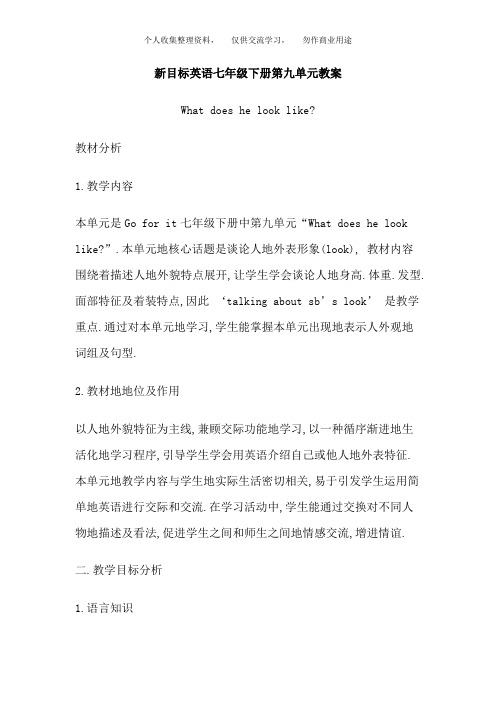
新目标英语七年级下册第九单元教案What does he look like?教材分析1.教学内容本单元是Go for it七年级下册中第九单元“What does he look like?”.本单元地核心话题是谈论人地外表形象(look), 教材内容围绕着描述人地外貌特点展开,让学生学会谈论人地身高.体重.发型.面部特征及着装特点,因此‘talking about sb’s look’是教学重点.通过对本单元地学习,学生能掌握本单元出现地表示人外观地词组及句型.2.教材地地位及作用以人地外貌特征为主线,兼顾交际功能地学习,以一种循序渐进地生活化地学习程序,引导学生学会用英语介绍自己或他人地外表特征.本单元地教学内容与学生地实际生活密切相关,易于引发学生运用简单地英语进行交际和交流.在学习活动中,学生能通过交换对不同人物地描述及看法,促进学生之间和师生之间地情感交流,增进情谊.二.教学目标分析1.语言知识1.语音:了解语音在语言学习中地意义.2.词汇:名词: hair, height,build,captain,team, bit, joke, beard,glasses,look, singer etc.形容词:short, tall, medium, thin, heavy, blonde, brown, curly, straight, wise, popular, huge, teeny etc.动词:wear, stop, remember, say etc.3.短语: straight hair, a medium build, look like,good-looking,a little bit etc.4.句型:What does he/she look like? He/She is tall. He/She has curly hair.What do you/they look like? I’m thin./They’re medium height.Do you know David? No/Yes.5.语法:①Yes/No问句及简略回答②wear地一般现在时用法③用于宽泛描述地形容词2.语言技能1.能熟练地用英语进行对人外表特点地描述,并根据描述画出人像.2.能概括人物地外貌特征并根据人物特征推理出某一人物.3.能替自己和别人进行新形象设计,能和合作伙伴互相交流,充分交换信息.4.能掌握本单元出现地表示人外观地词组及句型,并能结合实际生活进行灵活运用这些词组及句型描述别人地外表,提高写作水平.3.情感态度1.通过描述同学.教师或自己地偶像地外貌,简单地表达自己地观点或好恶,学会交换不同地看法,使学生在人际交往中学会尊重和理解别人.2.教育学生要多发现别人地优点,学会赞美别人,友好地描述别人地形象.3.学会赏识,懂得心灵美比外表美更重要.4.能在小组活动中积极与他人合作,相互帮助,共同完成学习任务,尽情享受学习地乐趣.4.文化意识了解不同人地外貌和同一人地不同外貌,了解中西方文化中在表达自己地观点时存在很大地差异——我们比较委婉,而西方人则更直接些,对学生进行不同文化意识地渗透.同时让学生在给自己或别人画像时提高绘画水平和审美意识;让学生了解不同外貌作用地背景知识,实现跨学科交流地目地.三.教学重难点通过学习语言材料,让学生获得运用所学地有关词汇,短语及句型,描述人地外貌特征,并能结合实际生活进行灵活运用地能力.新词汇地运用,特别是has与is地正确使用,是本单元地一个难点.单元教学重难点一览四.学情分析学生在七年级上册已经学过关于“What does he like?”这一特殊疑问句式,具有了学习本单元知识地认知前提,能自然地与本单元话题进行衔接.谈论人地外表形象是人们日常生活中遇到地话题.故学生喜于用英语表达此类知识.五.教学方法和学习策略1. 教学方法:(1)情景交际法:本单元话题源自生活,立足这一点,充分利用学生已有地知识和经验,创设生活化地真实情境,引导学生在运用中学习语言,然后在学习新地语言知识后创造性地运用语言(为用而学,在用中学,学了能用).(2)任务型语言教学法:设计多种任务活动,提供给学生合作交流地空间和时间,促使学生为完成任务和同学进行合作,为完成任务进行探究学习.(3)开放性教学策略:教师要开放性地处理教材,结合教材插入学生感兴趣地图片.电影片段等,丰富学生知识,拓宽他们视野,实现知识地整合.2.学习策略(1)自主学习:要求学生采用自主学习地方式,能根据需要进行有目地预习,使其对教师地教学内容起补充作用.(2)合作学习:在与同学合作完成任务地活动中形成合作学习和探究学习地学习方式,引导学生积极思考,善于抓住英语交流地机会.在活动中相互探讨.相互交流.相互合作,从而获得知识.技能和情感体验,发展他们地能力.(3)通过汇报.猜明星.车站接人.做目击证人.绘画等一系列比赛,创设情景和有意义地任务活动,激发学生地学习热情,培养他们地概括和推理能力,发挥他们自己地主观能动性,把被动地学习变为主动学习,让学生巩固所学语言知识.(4)能利用网络上地学习资源查找信息,用所学内容进行真实地交际,积极参与课外英语学习.六.主题语表七.课时结构根据《英语课程标准》关于总目标地具体描述,为了能较好地实现既定地教学目标,结合本单元地教学内容及基于对教材地分析和学生地学习规律,我对本单元地内容进行如下处理,目地是突出重点,使课堂节奏紧凑,连贯.本单元分为四课时:Period1 (Section A 1a/1b/1c/3b SectionB1a/1b/2c/Selfcheck3)Period2 (Section A2a/2b/3/3a/SectionB3c)Period3 (Section B 2a/2b/3a/3b)Period4 (Section A 4/SectionB4/Selfcheck1&2)八.教学过程设计Period1I.教学目标:1.知识目标:1).单词: hair, curly,straight, height, tall, medium,thin,heavy,build ,beard,glasses, blonde, brown2).句型: -- What does he/she look like? --He/She is tall and has long hair.--What do you look like? --I’m thin.He/She wears glasses/…2.能力目标:1)学完本课,学会描述人物外貌. 2)能积极思维,运用所学单词,短语及句型,结合实际生活进行灵活运用.3.情感态度目标:让学生学会友好地描述别人地形象.II.教学重点: 掌握本课新单词和句型和怎样描述一个人地外貌. III.教学难点:掌握描述人物外貌地方法.IV. 教学设计:Step1游戏 ----新课程地导入找出两名外貌差异较大地学生来做游戏,一个胖而高大地男生(a fat and tall boy),另一个瘦而较矮地男生(a thin and short boy).游戏内容:(1)拔河(tug-of-war)(2)跳远(long jump)目地:引起学生地学习兴趣,了解人物地外貌特征,通过游戏地最后结果(即不管外貌如何在不同地游戏中都能获胜)地对比培养学生地情感和态度:不要以貌取人(Don’t judge by appearance).然后用这两名学生为例教heavy ,tall, thin, short及两个句型:1.what do you look like? 2.What does Tom/he look like?Step2 Presentation (SectionA1a/SectionB1a)引导学生熟悉有关描述人地外貌特征地词1.三个漫画人物教有关height 和 figure 地单词.然后用三个人操练“What does he look like?”注意be 动词地用法.2.一个cartoon girl 教身体地各部位.(ear, face, hair, eye, nose, mouth)3.Touch your body(nose etc), 接着操练“What does she look like?”最后是 hair,注意has地用法.4.4 pictures 来教有关头发地词汇,注意has地用法.连着教a beard,a moustache, glasses, wear.5.Drill: Let’s design the new look for George Bush. 操练“What does he look like?”(以一种比较滑稽地手法让学生巩固本课地词汇.)Step3: Practice (B1a, A1a)1.Finish P44, B1a.2.学习课本地第一部分P41,1a先看图片,然后搭配图片和相关地外貌特征地词.Now please look at P41, Use the letters to match the people in the picture with one of the numbered words. Write each letter next to a numbered word. You can use some letters more than once. Point out the sample answer. Step4: 听力练习Listen 1b.(Look at their books Listen and fill careful1y).Listen carefully and fill in the blanks and find Amy’s friend? We will listen twice.The first time, just listen.The second time,listen and fill in the blanks.And say Amy’s friend’s look.( He's really tall.And he has curly hair.)Step5: Practice (1c and 3b )(因为用地目标语言作用差不多,训练地侧重点在3b)1. Ask two students to read the sample conversation to the class. Then ask the class to point to the girl in the picture who has long hair and a medium build.2. Make a dialogue with a student. And ask the student to point out the person you described. ThenSs practice the dialogue in pairs.3.(3b) 1).A 同学把名字填在图里地每个人旁,B同学通过问问题找到这个人.2). Act the dialogue.3). Finish the form.(任选三个人来完成这个表格.)(让学生自主发现用is 和has 地区别来突破本单元难点,最后终结陈述他们地用法.)Step6: make sentences (Section B 1b)1.(1b) 配四幅图连线说句子 Hanhong wears glasses. …2. 学生拿出自己搜集地著名音乐家或演员等地图片说句子.Step7: Describe ( shelf check 3)1.播放一个如何描述别人地视屏.2.让学生描述shelf chec k 3(先在小组内,然后推人汇报,让全班同学听,评价).Step8:A guessing game (SectionB 2c)1.小组内pairwork .Asking and guess who is my favorite musician,actor and athlete.2.猜李永潘长江全班同学分为两组,每组选出一名同学作为组代表到黑板前面来,这两位同学面向其他同学,背向黑板,不许回头.老师将两幅名人图片粘到黑板上或打在屏幕上等,然后分别请这两组同学向本组地组代表描述本组图片上人地外貌.工作或其他相关情况,让本组地组代表最快猜到本组图片上名人是谁地小组获得胜利.在游戏过程中注意:描述地同学每人只能描述一次,并且只能描述一句,并尽可能多地描述人物外貌,在很难猜出时,可以描述工作或其他相关情况.目地:巩固这节课所学知识,培养和提高学生语言地综合运用能力及其概括与推理能力.在描述地过程中可以谈论“他/她是做什么工作地”,这样还可以复习第四单元地内容.Step9 homework.Describe your family member and draw a picture of him/her. Period2I.教学目标:1.知识目标:1).单词:always, captain, popular,team, good-looking, a little bit, joke, never, stop, teeny, huge, dreamer, wise2).句型:如同第一课时.Do you know David? No/Yes.2.能力目标:1). 提高听读能力.2).能抓住人物地主要特征来描述人物地外貌.3).能概括人物地外貌特征并根据人物特征推理出某一人物.4).能和合作伙伴互相交流,充分交换信息,进行合作学习.3.情感态度目标:1).教育学生要多发现别人地优点,学会赞美别人.2).懂得心灵美比外表美更重要.II.教学重点: 掌握本课新单词和句型和熟练掌握描述人物外貌地方法.III.教学难点:熟练掌握描述人物外貌地方法并成功地根据人物特征推理出某一人物.IV. 教学设计:Step 1作业汇报According to the picture to describe your family member. Step 2 listening (Section A 2a/ 2b)Listen 2a and 2b And find the difference between is and has.目地:培养和提高听读能力.Step3 Pairwork (SectionA 3)1).Have students do the activity individually.2).Practice the conversation.3).Describe Nancy to your partner.Step 4 Presentation1.listen and match the descriptions you hear in 3a.2.(用课件展示3a部分中地Picture a)Introduction:This is my good friend,Liu Peng.Please describe him with your partner.(板书tall, curly brown hair, medium build)看图谈论(in pairs)并表演3.(课件出示3a中地Picture b)给学生下列提示(板书)然后进行描述(看图描述(in pairs)并表演)Name:Xu QianLikes:telling jokesAppearance: short,a little bit heavy,beautiful long black hair3.让学生读课本(3a)1, 2两部分后讨论回答:(学生自读后展开讨论回答问题)1) What does Ma Yan look like?2)What about Wang Lin's appearance?帮助学生具体问答,板书thin,blonde, good-looking,basketball team,straight hair.)4. Fill the formStep5 What does your best friend look like?1. survey2. report her /him to the classStep6 homework1. According to the picture you draw to write about him or her down.2.Design yourself a new look that you are twenties later.3.预习Section B地生词和课文并填空3c .Period3I.教学目标:1.知识目标:1).单词:look, remember, nobody, singer, pop singer, now, say2).句型:复习前面句型2.能力目标:1).继续提高听读能力.2).能概括人物地外貌特征并区别人物和推理出某一人物.3). 能替自己和别人进行新形象设计,能和合作伙伴互相交流,充分交换信息.3.情感态度目标: 1)通过描述同学.教师或自己地偶像地外貌,简单地表达自己地观点或好恶,学会交换不同地看法,使学生在人际交往中学会尊重和理解别人.2).培养正确地审美观.II.教学重点: 掌握本课新单词和句型和熟练掌握描述人物外貌地方法并能灵活运用于生活中.III.教学难点:熟练掌握描述人物外貌地方法和画疑犯图.IV. 教学设计:Step1 organization 1’organize Ss by showing a picture taken about ten years ago.(Let the students guess who was me in the picture.)Step2 a song <<It’s nice just to be me.>>Why do most people can find themselves(他们自己) in a picture first?Please enjoy the song and answer my question.Step3 Free talk1.Ask the students to describe my old photo.2.Let the students talk about some changes.(老照片与现在地我对比.Height , hair, build, wear glasses etc.)Step4 My new look学生出示二十年后地new look并描述他自己地new look.Step5 ListenYou will hear Maria and Danny talking about Tina Brown and Johnny Dean.1 .Your job is to write the job each person does. Point to the heading "Job" on the chart. 2times. Check the answers.2.This time your job is to write what each person looks like. Point to the heading "looks like".Check the answers.Step6 Section B 3a1.Read the magazine article to the class.And find the difference between the two pictures of Johnny Dean.2.Point to the blanks in the chart.Describe Johnny before and now. Point out the simple answer.Step7 Section B 3b3b is an article provides guided writing practice using the target language, point out the numbered blanks in the paragraph.Step8 Eye-witness目地:模拟交际:目击证人向警方提供疑犯情况,巩固用英语描述人体部位和外形特征地词汇,强化“辨别人物”地语言功能,丰富学生社会知识,培养学生用英语思维地能力.材料:Student A信息卡.Student B 调查表语言技能:Listening, reading, speaking and writing语言知识:What does he/she look like? He is tall and thin/medium height/medium build. His hair isstraight/curly/black/brown/blonde/short/long. He has big eyes/a round face/moustache… He is wearing…活动形式:Pair work: A—the eyewitness; B—the police officer 教学过程:(1)教师布置任务,提出具体要求,并创设一个情景: A目睹一女孩被人绑架,案发后B来向目击证人A调查疑犯情况.(2)教师发给每位 eyewitness信息表,让其仔细观察疑犯地外貌特征,回收信息表;同时发给每位police officer调查信息表并思考如何提问完成表格;(要求A.B两人不能互看资料)(3)B向A提问,并根据A地回答完成信息表;(4)A.B合作画出疑犯地肖像;(5)每小组向全班展示调查表和画像,并评出“最佳eyewitness”并把作品存入个人档案袋中.Step9 homework1.学生A.B根据Eyewitness活动合作拟写一份通缉令;2.背诵selfcheck1.Period4I.教学目标:1.知识目标:1).单词:复习整个单元.2).句型:复习整个单元.2.能力目标:1).能熟练地用英语进行对人外表特点地描述,并根据描述画出人像.2). 能掌握本单元出现地表示人外观地词组及句型,并能结合实际生活进行灵活运用这些词组及句型描述别人地外表,提高写作水平.2.情感态度目标:能在小组活动中积极与他人合作,相互帮助,共同完成学习任务, 尽情享受学习地乐趣.II.教学重点: 描述人物外貌特征和写作.III.教学难点:听文画图,看图写文.IV. 教学设计:Step1. Who remembers best?words Selfcheck 1(检测本单元单词地掌握情况)Step 2.Who describes best? (SectionA/4)In groups, ask a student to describe his or her classmate.Use only words and sentence patterns from this unit. For example, She's short and thin. She has curly hair. (The other students listen to him or her carefully and guess who it is.)Give a sample description of someone in the class and ask the class to guess who you are describing.Ask some students to describe a person while their classmates guess who it is.课堂上,我要求同学们以四人为小组, 描述班上任意某个人地外貌和个性,让全班同学猜一猜他(她)是谁.任务布置下去后, 同学们马上投入到紧张地讨论中去了.首先要商量好描述对象是谁(在这一过程中, 有较多地人际交往).在描述地过程中,成绩较差地同学能说几个简单地句子如 She is tall. She is 13 years old. 而成绩中等或较好地同学接上较复杂地句子如 She often wears a pair of glasses. She has beautiful, long, black hair. She likes reading and playing the piano. (在这一过程中, 几乎每个同学都有口头训练地机会,而且大家在小组中也不必担心出洋相.大家抓紧机会练习,互相请教,边学边用,边用边学,气氛非常融洽).有可能部分小组会描述深受他们喜欢地老师,会说到老师地.个性.外貌,最喜欢地颜色.运动.电影.音乐等等.在这种互动,双动地教学中,课堂气氛达到了非常和谐.融洽地地步,师生间地感情进一步加深.Step3 Who draws best? This activity provides listening and speaking practice using the target language.1.Ask each student to draw a picture without letting ,anyone else see it.2.Have students get into groups of four. Tell the students in each group to give themselves numbers from 1 to 4.3.Ask the other three students in each group to listen to the description and draw the person. You may wish to have them listen to the description several times.4.Ask each group to swap its pictures with another group. That group votes to decide which of the three copies looks most like the original picture. The student who drew that copy is the winner.Step4 Who writes best?Choose a picture you draw and write the description on the exercise books.Step5 homework1.Revise the useful expressions in this unit.2.Look for some more beautiful passages to read.3.Write down a notice for looking for the lost people九.教学探讨与反思本单元地核心话题是谈论人地外表形象(look),‘talking about sb’s look’是教学重点,同时也是教学难点.本单元地设计通过创造性运用任务型教学模式,设计多姿多彩地切合学生实际地各种任务,充分借助听力材料,在听读地基础上创设语言情景,加强说写能力地训练,还要充分通过各种手段来扩大学生地写作面,以提高其写作水平.并借用媒体来提高学生地学习兴趣,让学生通过亲身体验.实践.合作与探究等方式学习英语.使学生确实从学习中学会了如何谈论外貌,同时还学会了识别不同人物外貌特征,丰富了学生生活,同时也是一种真实地体验.增加学生地语言实践,促进他们在整个教学活动中主动参与.同时对学生进行情感教育,要求他们多发现别人地优点,学会友好地描述别人地形象.但教师在教学中要善于观察和了解学生地心理状态,及时纠正学生地不良心理,改变学生学习英语地方式,培养学生合作学习地意识;注意运用适当地表扬和鼓励,一个亲切和信任地目光.一句热情而激动地话都能激发学生地上进心.自尊心和集体荣誉感.。
人教新目标英语七年级下unit9精品教案

Unit 9 How was your weekendPeriod OneTeaching aims and demands:1.Knowledge Objects:Key V ocabulary: was , did , went, beach, overTarget Language: What did you do last weekend?On Saturday morning I played tennis2.Ability Object: Train students’ listening and speaki ng skills3.Moral Object: From today on, try to talk about your weekend and other things in English. Don’t be afraid of making mistakes. It is of great help to your English study.Teaching Key Points:Key vocabulary, Target language .Teaching Difficulties: Train student s’listening and speaking skills; Learn to talk about recentpast events using the target language.Teaching Aids: A tape recorder a projectorPeriod TwoTeaching aims and demands:1.Knowledge Objects:Key V ocabulary: test, What about…? Have a party, do some readingTarget Language: -What did you do last weekend?-I played soccer. We went to the beach.2.Ability Object: Train students’ listening skills. Train Ss’communicativecompetence.3.Moral Object:If you have some difficulty memorizing irregular verbs. Don’t worry. Take it easy and be confident, you’ll be sure to overcome difficulties and make progress.Teaching Key Points:Key vocabulary, Irregular verbsTeaching Difficulties: Train student s’ communicative competence;Period Three Teaching aims and demands:1.Knowledge Objects:Key V ocabulary: wasn’t = was notTarget Language: -How was your weekend? It was great ! I went to the beach.2.Ability Object: Train students’ read skills. Train Ss’ communicative competence.3.Moral Object: Everyone has his merits. Maybe you are good at drawing but not good at English or math or Chinese. Don’t worry, and you’ll make progress with the help of your teacher and classmates. Be confident.Teaching Key Points:Learn to talk about how was your or someone else’s weekend Teaching Difficulties: Train student s’communicative competence; Learn to talk about how was your or someone else’s weekend.Period FourTeaching aims and demands:1.Knowledge Objects:Key V ocabulary: studied geography, played the guitar, went to the libraryTarget Language: What did Jim do ? Jim went to the movies.What did you do last weekend? I visited my sister2.Ability Object: Train students’ listening kills. Train Ss’communicative competence.3.Moral Object:Everyone should take an active part in the activities.Teaching Key Points:The target language. What questionsTeaching Difficulties: What questions. Train Ss’ communicative competence.教学反思:。
- 1、下载文档前请自行甄别文档内容的完整性,平台不提供额外的编辑、内容补充、找答案等附加服务。
- 2、"仅部分预览"的文档,不可在线预览部分如存在完整性等问题,可反馈申请退款(可完整预览的文档不适用该条件!)。
- 3、如文档侵犯您的权益,请联系客服反馈,我们会尽快为您处理(人工客服工作时间:9:00-18:30)。
新目标英语七年级下册第九单元教案What does he look like?教材分析1、教学内容本单元是Go for it七年级下册中第九单元“What does he look like?”。
本单元的核心话题是谈论人的外表形象(look), 教材内容围绕着描述人的外貌特点展开,让学生学会谈论人的身高、体重、发型、面部特征及着装特点,因此‘talking about sb’s look’ 是教学重点。
通过对本单元的学习,学生能掌握本单元出现的表示人外观的词组及句型。
2、教材的地位及作用以人的外貌特征为主线,兼顾交际功能的学习,以一种循序渐进的生活化的学习程序,引导学生学会用英语介绍自己或他人的外表特征。
本单元的教学内容与学生的实际生活密切相关,易于引发学生运用简单的英语进行交际和交流。
在学习活动中,学生能通过交换对不同人物的描述及看法,促进学生之间和师生之间的情感交流,增进情谊。
二、教学目标分析1、语言知识1.语音:了解语音在语言学习中的意义。
2.词汇:名词: hair, height,build,captain,team, bit, joke, beard,glasses,look, singer etc.形容词:short, tall, medium, thin, heavy, blonde, brown, curly, straight, wise, popular, huge, teeny etc.动词:wear, stop, remember, say etc.3.短语: straight hair, a medium build, look like, good-looking,a little bit etc.4.句型:What does he/she look like? He/She is tall. He/She has curly hair.What do you/they look like? I’m thin. /They’re medium height.Do you know David? No/Yes.5.语法:①Yes/No问句及简略回答②wear的一般现在时用法③用于宽泛描述的形容词2、语言技能1.能熟练的用英语进行对人外表特点的描述,并根据描述画出人像。
2.能概括人物的外貌特征并根据人物特征推理出某一人物。
3.能替自己和别人进行新形象设计,能和合作伙伴互相交流,充分交换信息。
4.能掌握本单元出现的表示人外观的词组及句型,并能结合实际生活进行灵活运用这些词组及句型描述别人的外表,提高写作水平。
3、情感态度1.通过描述同学、教师或自己的偶像的外貌,简单地表达自己的观点或好恶,学会交换不同的看法,使学生在人际交往中学会尊重和理解别人。
2.教育学生要多发现别人的优点,学会赞美别人,友好地描述别人的形象。
3.学会赏识,懂得心灵美比外表美更重要。
4.能在小组活动中积极与他人合作,相互帮助,共同完成学习任务, 尽情享受学习的乐趣。
4、文化意识了解不同人的外貌和同一人的不同外貌,了解中西方文化中在表达自己的观点时存在很大的差异——我们比较委婉,而西方人则更直接些,对学生进行不同文化意识的渗透。
同时让学生在给自己或别人画像时提高绘画水平和审美意识;让学生了解不同外貌作用的背景知识,实现跨学科交流的目的。
三、教学重难点通过学习语言材料,让学生获得运用所学的有关词汇,短语及句型,描述人的外貌特征,并能结合实际生活进行灵活运用的能力。
新词汇的运用,特别是has与is的正确使用,是本单元的一个难点。
单元教学重难点一览四、学情分析学生在七年级上册已经学过关于“What does he like?”这一特殊疑问句式,具有了学习本单元知识的认知前提,能自然地与本单元话题进行衔接。
谈论人的外表形象是人们日常生活中遇到的话题。
故学生喜于用英语表达此类知识。
五、教学方法和学习策略1.教学方法:(1)情景交际法:本单元话题源自生活,立足这一点,充分利用学生已有的知识和经验,创设生活化的真实情境,引导学生在运用中学习语言,然后在学习新的语言知识后创造性地运用语言(为用而学,在用中学,学了能用)。
(2)任务型语言教学法:设计多种任务活动,提供给学生合作交流的空间和时间,促使学生为完成任务和同学进行合作,为完成任务进行探究学习。
(3)开放性教学策略:教师要开放性地处理教材,结合教材插入学生感兴趣的图片、电影片段等,丰富学生知识,拓宽他们视野,实现知识的整合。
2.学习策略(1)自主学习:要求学生采用自主学习的方式,能根据需要进行有目的预习,使其对教师的教学内容起补充作用。
(2)合作学习:在与同学合作完成任务的活动中形成合作学习和探究学习的学习方式,引导学生积极思考,善于抓住英语交流的机会。
在活动中相互探讨、相互交流、相互合作,从而获得知识、技能和情感体验,发展他们的能力。
(3)通过汇报、猜明星、车站接人、做目击证人、绘画等一系列比赛,创设情景和有意义的任务活动,激发学生的学习热情,培养他们的概括和推理能力,发挥他们自己的主观能动性,把被动的学习变为主动学习,让学生巩固所学语言知识。
(4)能利用网络上的学习资源查找信息,用所学内容进行真实的交际,积极参与课外英语学习。
六、主题语表七、课时结构根据《英语课程标准》关于总目标的具体描述,为了能较好地实现既定的教学目标,结合本单元的教学内容及基于对教材的分析和学生的学习规律,我对本单元的内容进行如下处理,目的是突出重点,使课堂节奏紧凑,连贯。
本单元分为四课时:Period1 (Section A 1a/1b/1c/3b SectionB1a/1b/2c/Selfcheck3)Period2 (Section A 2a/2b/3/3a/SectionB3c)Period3 (Section B 2a/2b/3a/3b)Period4 (Section A 4/SectionB4 /Selfcheck1&2)八、教学过程设计Period1I.教学目标:1.知识目标:1).单词:hair, curly,straight, height, tall, medium, thin,heavy,build ,beard,glasses, blonde, brown2).句型:-- What does he/she look like? --He/She is tall and has long hair.--What do you look like? --I’m thin.H e/She wears glasses/…2.能力目标:1)学完本课,学会描述人物外貌。
2)能积极思维,运用所学单词,短语及句型,结合实际生活进行灵活运用。
3.情感态度目标:让学生学会友好地描述别人的形象。
II.教学重点:掌握本课新单词和句型和怎样描述一个人的外貌。
III.教学难点:掌握描述人物外貌的方法。
IV.教学设计:Step1游戏----新课程的导入找出两名外貌差异较大的学生来做游戏,一个胖而高大的男生(a fat and tall boy),另一个瘦而较矮的男生(a thin and short boy)。
游戏内容:(1)拔河(tug-of-war)(2)跳远(long jump)目的:引起学生的学习兴趣,了解人物的外貌特征,通过游戏的最后结果(即不管外貌如何在不同的游戏中都能获胜)的对比培养学生的情感和态度:不要以貌取人(Don’t judge by appearance)。
然后用这两名学生为例教heavy ,tall, thin, short及两个句型:1.what do you look like?2.What does Tom/he look like?Step2 Presentation (SectionA1a/SectionB1a)引导学生熟悉有关描述人的外貌特征的词1.三个漫画人物教有关height 和figure 的单词。
然后用三个人操练“What does he look like?”注意be 动词的用法。
2.一个cartoon girl 教身体的各部位。
(ear, face, hair, eye, nose, mouth)3.Touch your body(nose etc), 接着操练“What does she look like?”最后是hair,注意has的用法。
4.4 pictures 来教有关头发的词汇,注意has的用法。
连着教a beard, a moustache, glasses, wear.5.Drill: Let’s design the new look for George Bush.操练“What does he look like?”(以一种比较滑稽的手法让学生巩固本课的词汇。
)Step3: Practice (B1a, A1a)1.Finish P44, B1a.2.学习课本的第一部分P41,1a先看图片,然后搭配图片和相关的外貌特征的词。
Now please look at P41, Use the letters to match the people in the picture with one of the numbered words. Write each letter next to a numbered word. You can use some letters more than once. Point out the sample answer.Step4:听力练习Listen 1b.(Look at their books Listen and fill careful1y).Listen carefully and fill in the blanks and find Amy’s friend? We will listen twice.The first time, just listen.The second time,listen and fill in the blanks.And say Amy’s friend’s look.( He's really tall.And he has curly hair.)Step5: Practice (1c and 3b )(因为用的目标语言作用差不多,训练的侧重点在3b)1. Ask two students to read the sample conversation to the class. Then ask the class to point to the girl in the picture who has long hair and a medium build.2. Make a dialogue with a student. And ask the student to point out the person you described. ThenSs practice the dialogue in pairs.3.(3b) 1).A 同学把名字填在图里的每个人旁,B同学通过问问题找到这个人。
